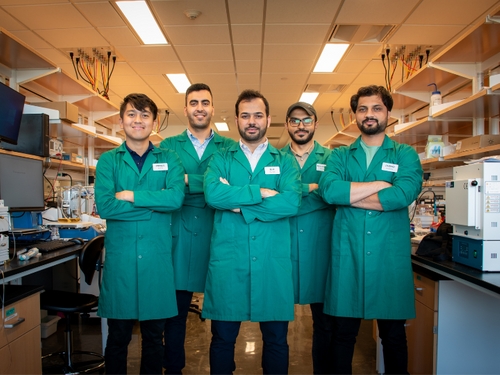UH Researchers Developing Electrochemical Oceanic Carbon Capture Technology

Mim Rahimi, assistant professor (center) with his doctoral students (left to right) Prince Aleta, Mohsen Afshari, Abdelrahman Refaie and Ahmad Hassan
A team of scientists at the University of Houston (UH) led by Mim Rahimi, assistant professor of environmental engineering at UH’s Cullen College of Engineering, are developing a negative emissions technology called electrochemical direct ocean capture (eDOC), which helps the ocean cleanse itself of harmful carbon dioxide.
Funded by a $250,000 grant from the US Department of Energy, Rahimi and his team are working to create electrochemical tubes to remove dissolved inorganic carbon from synthetic seawater. Preliminary research on the project was sponsored by UH Energy’s Center for Carbon Management in Energy. The concept is detailed in a paper published in the journal Energy & Environmental Science.
Earth’s carbon dioxide is stored in the atmosphere and the terrestrial biosphere, but the vast majority is found in oceans. According to World Ocean Review, the planet’s five oceans contain 38,000 gigatons of CO2. Furthermore, United Nations climate experts say oceans absorb 25% of all carbon dioxide emissions and capture 90% of the excess heat generated by those emissions, making it a vital buffer against climate change.
“Electrochemical direct ocean capture amplifies the ocean’s ability to absorb carbon, sidestepping the expensive sorption process typical in many current strategies,” Rahimi said. “The promise of eDOC is undeniable, but scaling it, optimizing costs and achieving peak efficiency remain challenges we’re actively addressing.”
Current efforts to remove carbon dioxide from the ocean mainly involve complex processes like electrolysis, which attempt to either turn dissolved inorganic carbon into gas or convert it into magnesium or calcium carbonates. However, these techniques are energy-intensive and costly due to the use of rare and expensive materials, such as platinum and specialized membranes that easily clog, degrading their performance.
The researchers’ alternative strategy eliminates the need for those costly membranes. Instead, it relies on a process that adjusts the acidity of seawater using affordable and environmentally friendly electrode materials. The system promises to be more cost effective and also significantly reduces the environmental impact of traditional carbon removal efforts.
“While membrane-based systems showed promise, they come with challenges,” said Prince Aleta, a doctoral student in Rahimi’s lab. “We’re using electricity instead of thermal-based methods, and our current trajectory emphasizes systems without membranes for heightened efficiency.”
One of the key advantages of this innovation is its versatility and scalability. The system can easily be integrated into existing onshore infrastructure, such as desalination plants, as well as offshore locations like oil rigs.
“While eDOC won’t single-handedly turn the tide on climate change, it enriches our mitigation toolkit,” added Rahimi. “In this global challenge, every innovative approach becomes invaluable.”













 December 2025
December 2025



